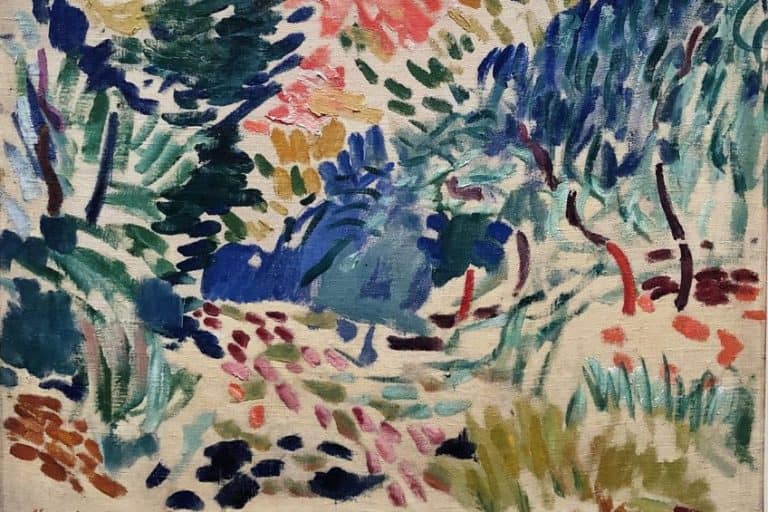“The Embarkation for Cythera” by Jean-Antoine Watteau – Analysis
Jean-Antoine Watteau’s masterpiece, The Embarkation for Cythera, epitomizes the elegance and charm of the Rococo period. Created in 1717, this painting captures a romanticized vision of lovers departing for Cythera, the mythological island of love. Watteau’s delicate brushwork and soft color palette bring to life a dreamlike scene filled with amorous couples and ethereal landscapes, reflecting the fleeting and ephemeral nature of love. As one of Watteau’s most celebrated works, The Embarkation for Cythera not only showcases his exceptional talent but also serves as a quintessential representation of the playful and idyllic spirit of early 18th-century French art.
Key Takeaways
- Jean-Antoine Watteau’s The Embarkation for Cythera is a prime example of Rococo painting.
- The painting depicts lovers preparing to depart for the mythical Cythera and was submitted to the Royal Academy in 1717.
- Currently housed in the Louvre, the artwork is celebrated for its depiction of love and fantasy.
Artist and Context
| Artist | Jean-Antoine Watteau (1684 – 1721) |
| Date Created | 1717 |
| Medium | Oil on canvas |
| Genre | Fête Galante |
| Period/Movement | Rococo |
| Dimensions (cm) | 129 x 194 |
| Series/Versions | Two versions; one in 1717 (Louvre) and another between 1718 and 1719 (Charlottenburg Palace) |
| Where Is It Housed? | Louvre Museum, Paris, France |
| What It Is Worth | Estimated at over $50 million (value based on historical significance and rarity) |
Jean-Antoine Watteau’s The Embarkation for Cythera is a fascinating window into 18th-century French Rococo painting. This artwork, also known as Voyage to Cythera and Pilgrimage to the Isle of Cythera, captures a scene of lovers preparing to depart for the mythical island of Cythera, the birthplace of Venus, the goddess of love. The painting, which Watteau submitted as his reception piece to the Royal Academy of Painting and Sculpture in 1717, showcases his mastery in depicting whimsical and romantic scenes.
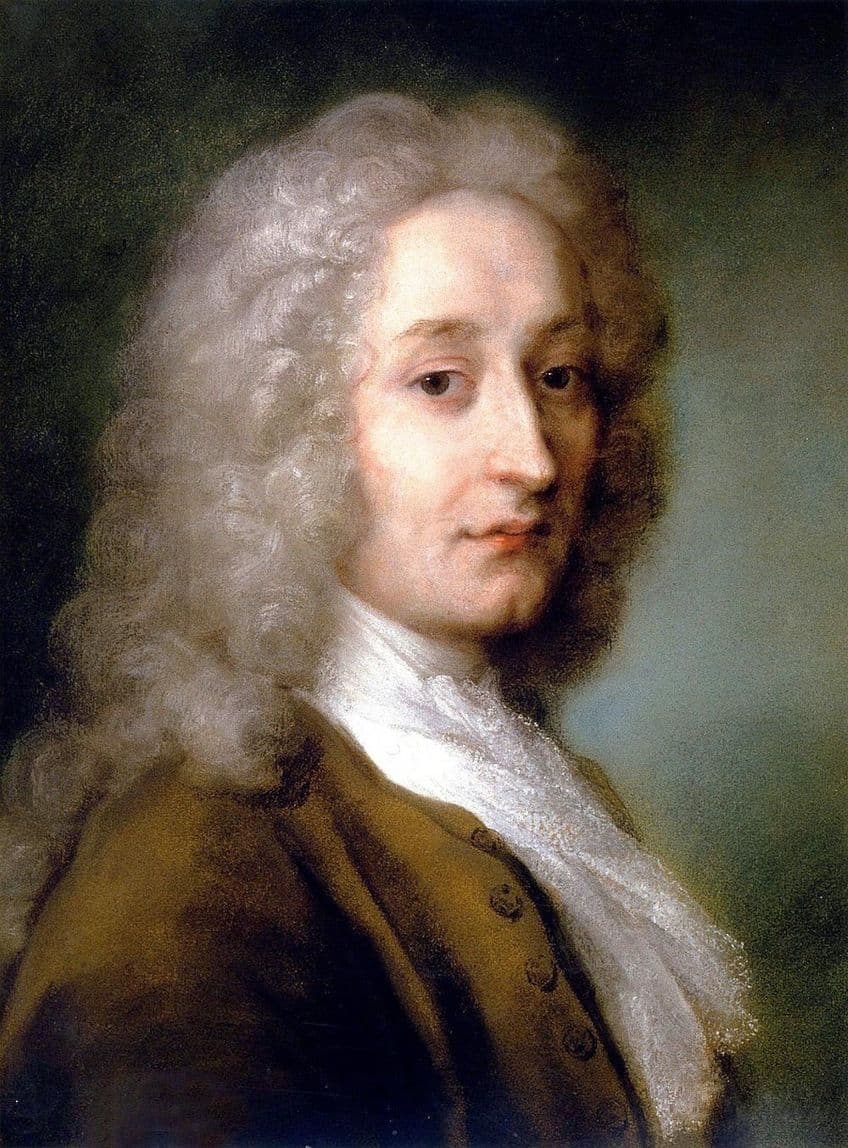
Watteau, an influential figure in the Rococo movement, brought an airy, playful quality to his compositions, setting him apart from his contemporaries. Born in Valenciennes, France, Watteau moved to Paris in the early 1700s, where he made a significant impact on the art world. His unique style, combining elements of fantasy and grace, is evident in The Embarkation for Cythera, a testament to his ingenuity and artistic vision. Housed in the Louvre Museum in Paris, the painting remains a key piece of French cultural heritage. Art enthusiasts and scholars alike continue to admire its delicate interplay of light and color, as well as its evocative portrayal of love and longing.
Through this masterpiece, Watteau not only defined the Rococo era but also left an enduring legacy that continues to inspire.
Jean-Antoine Watteau’s Background
Jean-Antoine Watteau was born in Valenciennes, France in 1684. Valenciennes was then part of the Spanish Netherlands but became French territory shortly before his birth. Watteau’s early life in this region influenced his artistic style. Watteau moved to Paris as a young man. There, he studied under Claude Gillot and later worked with Claude Audran. His time in Paris exposed him to various artistic influences, including the theater, which became a recurring theme in his work. Watteau’s style is known for its elegance and grace, often depicting scenes of leisure and romance. His works are characterized by their light color palette and flirtatious, playful subjects, which became hallmarks of the Rococo style.
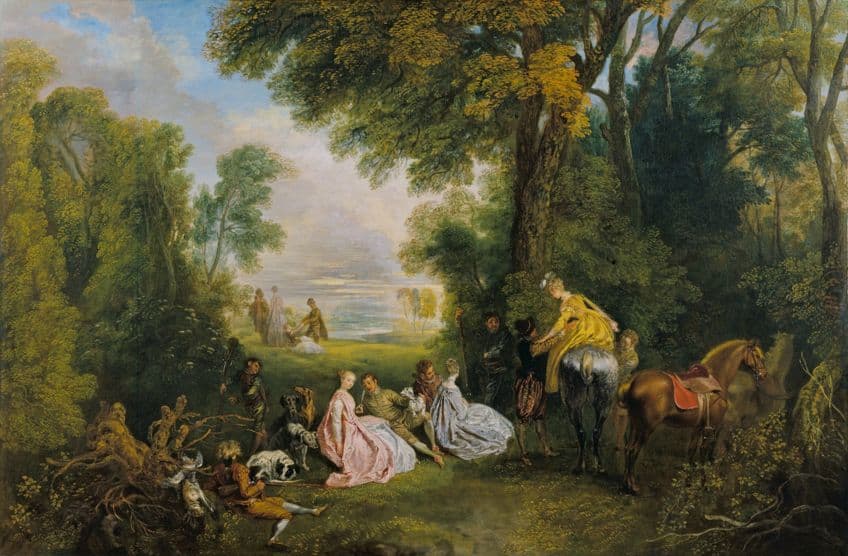
Cultural and Historical Setting
The early 18th century in France was a period of transition. The grandeur of Louis XIV’s reign had ended, and the more relaxed and pleasure-seeking Rococo culture began to emerge. This period was marked by a shift away from the strict, formal art of the previous regime. The French society of this time indulged in luxury and escapism, which is evident in Watteau’s work. His paintings often depicted aristocrats enjoying leisurely activities, reflecting the societal emphasis on pleasure and beauty. The Revolution was still a few decades away, so the aristocracy’s opulent lifestyle and the broader culture of the time are captured in Watteau’s paintings.
His work provides a window into the Rococo era’s ideals and aesthetics, showcasing a world where artful elegance dominated.
Analyzing the Masterpiece
The Embarkation for Cythera by Jean-Antoine Watteau is a significant work in the Rococo movement. This piece captures themes of love and fantasy through its unique composition.
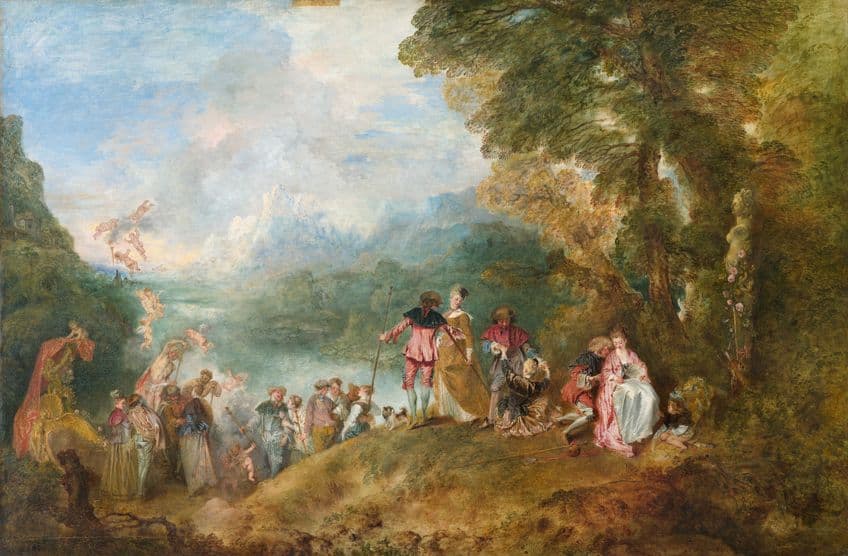
Artistic Style and Movements
Jean-Antoine Watteau played a pivotal role in the Rococo movement. Characterized by light colors, fluid lines, and playful themes, this style is evident in The Embarkation for Cythera. Watteau specialized in the genre of fête galante, which depicted aristocratic festivities in idyllic settings. This painting is a prime example, demonstrating the light-hearted, romantic nature of Rococo art. The painting also reflects the influence of classical themes.
Cythera, a mythical island associated with Venus, the Goddess of Love, represents the allegorical elements typical in Watteau’s work.
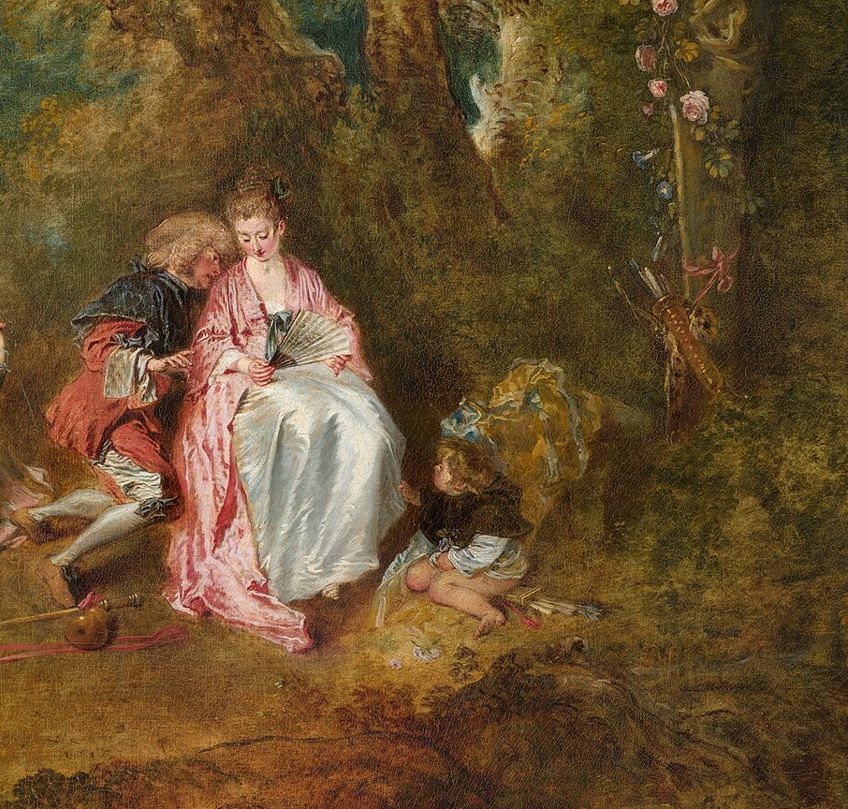
Analysis of Composition and Subject
The composition of The Embarkation for Cythera is highly structured and balanced. Watteau uses a flowing arrangement of figures leading the viewer’s eye across the scene. Couples dressed in elegant clothing prepare to depart for Cythera, symbolizing the pursuit of love. Watteau’s use of color and light is masterful. Soft pastels dominate the scene, creating a dreamy atmosphere that enhances the painting’s romantic theme. The balance between natural landscapes and human figures adds depth and realism. The subject matter is rich with allegory. Cythera, as the birthplace of Venus, signifies a utopia of love and happiness.
Through this, Watteau captures the ephemeral nature of human joy, a recurrent theme in his work and Rococo art.
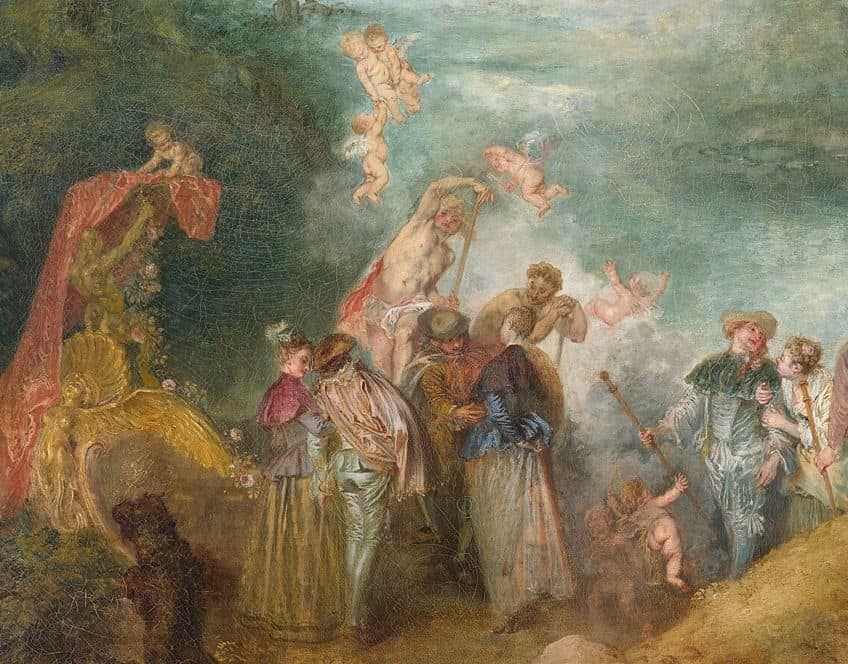
The Painting’s Legacy
The Embarkation for Cythera by Jean-Antoine Watteau has left a significant mark on art history. The painting’s influence and the care taken in its display and preservation highlight its importance in the Rococo Art Movement and beyond.
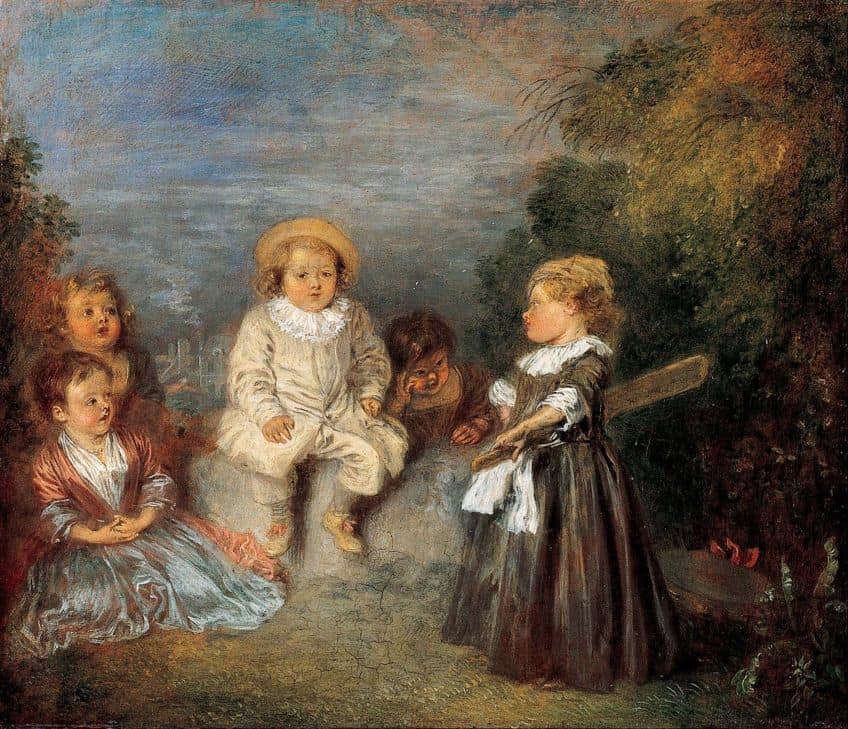
Influence and Reception
The painting’s initial reception was remarkably positive, securing Watteau a place at the Royal Academy of Painting and Sculpture in 1717. It showcased his ability to blend mythology with real-life sensibilities, capturing the temporary nature of human happiness. Art critics and historians praised its delicate brushwork and the use of soft, luminous colors, typical of the Rococo style. Jean-Antoine Watteau’s innovative approach influenced many subsequent artists, particularly in France and Germany. His depiction of an idyllic, almost dreamlike scene resonated during a time when the exploration of emotional and sensual beauty was gaining momentum.
The Embarkation for Cythera is often linked to cultural movements that emphasized romance and the ephemeral. Over the centuries, it has been studied and revered in art circles in places such as London and Berlin, cementing its status as a seminal work in European art history.
Display and Conservation
One of the most famous versions of this painting is housed in the Louvre Museum in Paris, where it has been prominently displayed for generations. Efforts to preserve the painting have been ongoing to ensure the integrity of Watteau’s original work remains intact. Another version can be found at the Städtische Galerie im Städelschen Kunstinstitut in Frankfurt, Germany. This variant also draws significant visitor attention and academic study. Additionally, a version of the painting is held at the Charlottenburg Palace in Berlin.
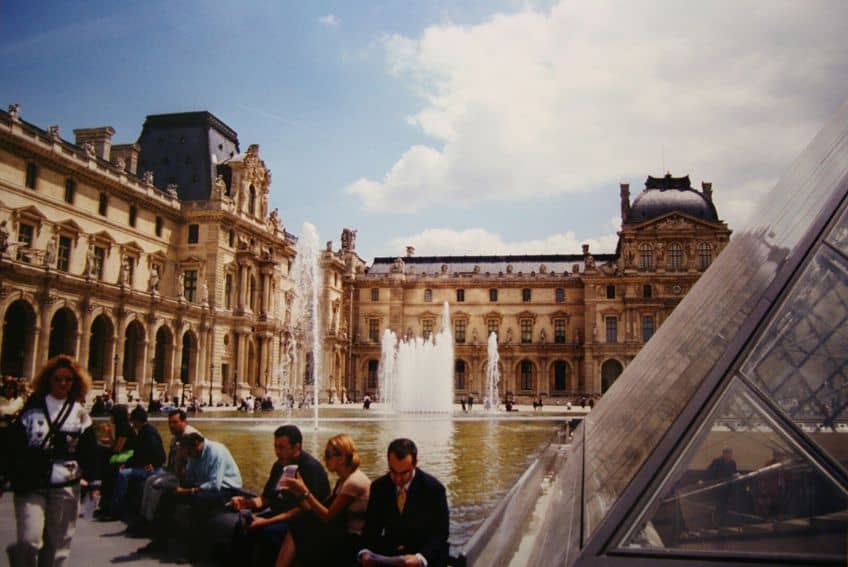
The conservation efforts in these museums involve state-of-the-art techniques to address issues like paint deterioration and canvas aging. Proper climate control and careful handling are critical to maintaining the paint’s delicate hues and the intricate details that Watteau so meticulously crafted. Careful documentation and scholarly research continue to shed light on Watteau’s techniques and the painting’s historical context, ensuring that The Embarkation for Cythera can inspire future generations.
The Embarkation for Cythera by Jean-Antoine Watteau remains a quintessential representation of Rococo artistry, encapsulating the era’s delicate sensibilities and romantic idealism. Through its masterful composition and enchanting ambiance, the painting invites viewers to partake in a poetic journey to an idyllic realm of love and beauty. Watteau’s innovative approach and nuanced portrayal of human emotion not only cemented his legacy as a pioneering artist but also influenced subsequent generations of painters. The Embarkation for Cythera continues to be celebrated for its timeless allure and its profound impact on the trajectory of French art.
Frequently Asked Questions
What Symbolism Is Depicted in Watteau’s The Embarkation for Cythera?
The painting illustrates a pilgrimage to Cythera, the mythical birthplace of Venus. This setting symbolizes love and beauty. The figures in the painting are often interpreted as embodying the transient nature of human happiness and romantic love.
How Does The Embarkation for Cythera Reflect Rococo Artistic Styles?
Watteau’s piece exemplifies the Rococo style with its lightness, elegance, and use of pastel colors. The playful, romantic scenes and intricate details are hallmarks of the Rococo aesthetic, distinguishing it from the preceding Baroque style.
What Is the Historical Significance of Watteau’s Painting With Regard to the Development of European Art?
Created in 1717, this painting was Watteau’s reception piece for the Royal Academy of Painting and Sculpture. It marked a departure from the grandiosity of Baroque art, influencing a new, more intimate, and decorative artistic movement that spread across Europe.
What Artistic Techniques Did Watteau Employ in The Embarkation for Cythera to Convey Its Themes?
Watteau used delicate brushwork and soft, diffused lighting to create an ethereal atmosphere. His use of color and composition leads the viewer’s eye through the scene, enhancing the lyrical and dreamlike quality of the painting.
Isabella studied at the University of Cape Town in South Africa and graduated with a Bachelor of Arts majoring in English Literature & Language and Psychology. Throughout her undergraduate years, she took Art History as an additional subject and absolutely loved it. Building on from her art history knowledge that began in high school, art has always been a particular area of fascination for her. From learning about artworks previously unknown to her, or sharpening her existing understanding of specific works, the ability to continue learning within this interesting sphere excites her greatly.
Her focal points of interest in art history encompass profiling specific artists and art movements, as it is these areas where she is able to really dig deep into the rich narrative of the art world. Additionally, she particularly enjoys exploring the different artistic styles of the 20th century, as well as the important impact that female artists have had on the development of art history.
Learn more about Isabella Meyer and the Art in Context Team.
Cite this Article
Isabella, Meyer, ““The Embarkation for Cythera” by Jean-Antoine Watteau – Analysis.” Art in Context. June 13, 2024. URL: https://artincontext.org/the-embarkation-for-cythera-by-jean-antoine-watteau/
Meyer, I. (2024, 13 June). “The Embarkation for Cythera” by Jean-Antoine Watteau – Analysis. Art in Context. https://artincontext.org/the-embarkation-for-cythera-by-jean-antoine-watteau/
Meyer, Isabella. ““The Embarkation for Cythera” by Jean-Antoine Watteau – Analysis.” Art in Context, June 13, 2024. https://artincontext.org/the-embarkation-for-cythera-by-jean-antoine-watteau/.








